FOREX stands for foreign exchange and the foreign exchange market. Forex (FX) is an international market for trading currencies.
The foreign exchange market determines the relative values of different currencies. It subsequently enables currency conversion. The foreign exchange market is essential for international trade, i.e., importing and exporting products.
Large international banks mainly control Forex. It is also by far one of the most liquid markets.
It is an over-the-counter market, i.e., traders negotiate directly with each other. There is no form of central house.
There are many markets, apart from forex, in which to trade. There are indices, shares, cryptocurrencies, commodities, and several others.

Forex turnover
The average daily turnover in global foreign exchange markets is estimated at $3.98 trillion, according to the “Triennial Central Bank Survey of Foreign Exchange and Derivatives Market Activity in 2010”.
According to Oxford Dictionaries, ‘Forex‘ is the abbreviation for ‘foreign exchange.’
On an average trading day, the Forex market generates:
- $1.765 trillion in foreign exchange swaps
- $1.490 trillion in spot transactions
- $475 billion in outright forwards
- $207 billion in options and other products
- $43 billion in currency swaps
The Forex market is open 24 hours a day for five and a half days a week. The market opens in the main global financial centers. London, Tokyo, Hong Kong, Singapore, and New York, for example, are major global financial centers. Sydney and Frankfurt are also major global financial centers.
Forex market size
Forex traders include governments, central banks, large banks, and financial institutions. Corporations and currency speculators are also Forex traders.
The Forex market’s activity is geographically concentrated in a few major financial hubs. London (UK) remains the world’s largest FX trading center, although its share has edged down post-Brexit. In April 2022, the UK accounted for about 38% of global Forex turnover, down from about 43% in 2019. The United States is the second-largest center with roughly 19% of global volume (up from ~17% in 2019).
Asia has two of the top five centers: Singapore (now the third-largest center, 9% of global turnover, up from 8% ) and Hong Kong (7%, down from 8%, partly due to COVID-era restrictions). Japan (Tokyo) accounts for around 4–5% of global Forex volume.
The table below shows the growth of global daily Forex turnover since 2004, based on the BIS Triennial Surveys (conducted every three years in April):
|
Year (April) |
Daily Turnover |
Change (since prior survey) |
|---|---|---|
|
2004 |
$1.9 trillion |
– (base year) |
|
2007 |
$3.3 trillion |
+74% vs 2004 |
|
2010 |
$4.0 trillion |
+21% vs 2007 |
|
2013 |
$5.3 trillion |
+33% vs 2010 |
|
2016 |
$5.1 trillion |
–5% vs 2013 (slight dip) |
|
2019 |
$6.6 trillion |
+29% vs 2016 |
|
2022 |
$7.5 trillion |
+14% vs 2019 |
Source: BIS Triennial Central Bank Surveys. The growth has been significant over the long term (nearly 4× since 2004), though the 2019–2022 increase (+14%) was relatively modest.
Since 2004 foreign exchange trading has more than tripled.
Top 10 Currency Trading Institutions
The global Forex market’s volume is intermediated by a relatively small number of large banks and specialized dealers. According to the Euromoney FX Survey 2022, which covers client volumes in calendar-year 2021), the top 10 Forex trading institutions and their estimated global market share were as follows:
|
Rank |
Institution |
Global FX Market Share |
|---|---|---|
|
1 |
Deutsche Bank |
10.89% |
|
2 |
UBS |
9.69% |
|
3 |
J.P. Morgan |
8.67% |
|
4 |
State Street |
7.66% |
|
5 |
XTX Markets (non-bank) |
7.14% |
|
6 |
Jump Trading (non-bank) |
5.60% |
|
7 |
Citi |
4.54% |
|
8 |
Bank of New York Mellon |
4.30% |
|
9 |
Bank of America Merrill Lynch |
3.73% |
|
10 |
Goldman Sachs |
3.65% |
The most traded currency pairs are (approximately):
- EUR/USD: ~23% of global turnover (the dominant pair by far)
- USD/JPY: ~13.5%
- GBP/USD: ~9.5%
- USD/CNY: ~6–7%
- USD/CAD: ~5.5%
- AUD/USD: ~5%
The three ways of trading Forex
There are three different ways to trade foreign exchange currencies: the spot market, the forwards market, and the futures market.
The Spot Market
A spot trade is a ‘direct exchange’ with a very short time frame, i.e., up to two working days.
It is between two different currencies relative to their current market price. Supply and demand, i.e., market forces, influence their price.
There is no contract in the spot market, and neither is there any interest involved in the transaction.
A Forward Transaction
A forward transaction does not involve an immediate exchange of money.
Instead, the parties agree to carry out the transaction on a specific future date. The traders decide on an exchange rate for that date, and the deal subsequently takes place on that date.
Futures
These are sold as a standard size and settlement date on public commodities markets. On average, a future contract length is around three months.
Types of exchange rate
There are two types of exchange rates:
1. A floating exchange rate, where the forces of supply and demand determine the value of a currency.
2. A fixed exchange rate, in which the government determines, i.e., ‘fixes,’ the value of a currency. It either pegs the currency to a major one or a basket of currencies. Alternatively, it may peg the currency to the value of a precious metal. Devaluations can only happen to currencies on a fixed exchange rate.
The agility of the Forex market to respond to global economic events makes it a vital barometer for international financial health and investor sentiment.
